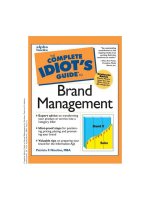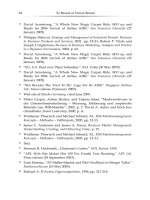strategic brand management
Bạn đang xem bản rút gọn của tài liệu. Xem và tải ngay bản đầy đủ của tài liệu tại đây (2 MB, 126 trang )
Strategic Brand Management
Overview
What is a Brand?
• A brand is a name, term, sign, symbol or
design, or a combination of them, intended
to identify the goods or services of one seller
or group of sellers and to differentiate them
from those of competitors.
• A global brand is a brand that is
recognised throughout much of the world.
Power Brands
p.3
The Top Determinants of Brand
Strength
“I Would Travel Further”
“I Would Pay More”
Customer Loyalty
“I Would Wait Longer”
Price Premium
“An increase in customer loyalty of only 5% can lift lifetime profits per customer by as
much as 95%”
“In some sectors, an increase of customer loyalty of just 2% is equivalent to a 10% cost
reduction”
“Over 50% of customers would be willing to pay 20-25% price premium to the brand that
they are most loyal to”
“A 1% increase in brand equity can result in a 1% increase in stock price”
“50% of customers are willing to try a new product from a preferred brand because of the
implied endorsement, credibility and trust.”
“It takes 7 to 10 times the cost and effort to gain a new customer as it does to keep an
existing customer”
What is Brand Management?
Functional Excellence in
Support of the Brand
Firm wide Leadership in
Stewarding the Brand
Primary Source of Differentiation
Primary Source of Differentiation
• Product/service innovation and
communication
• Customer experience, in addition to
innovation and communication
Purpose of the Brand
Purpose of the Brand
• Create or reinforce product
• Provide clear set of values along
which to align all enterprise activities
and investments
distinctiveness
Source: Corporate Executive Board
What is Brand Management?
Innovative Analysts
Archeologists
Sociologists
Politicians
CONSUMER
Brand
Champions
General Managers CHAMPION
Templar Knights of Equity
Evangelists
Brand Stewards
What is Brand Management?
“You have to maintain and replenish
a brand over time or it will die”
What is a Brand Management?
• Brand Building Begins By
– Understanding & anticipating the needs and
desires of the consumer
– Understanding the key attributes of the
product(s)
• Our Mission is to DISCOVER (rather than
Invent) the brand’s CORE VALUES and
abide by them.
Customer-Based Brand Equity (CBBE)
Model
Can there be Positive or Negative
Brand Equity?
How and Why?
1 Consumer Response to
Marketing
2 Brand Knowledge
3 Differential Effect
Brand Equity arises from
differences in CONSUMER
response
What CONSUMERS learned,
felt, seen, heard, experienced
over time
Reflected in CONSUMER
perceptions, preferences, and
behavior related to all aspects
of the marketing of a brand
Effect of Brand Perceptions
Taste Perceptions
w/Brand Knowledge
* Heineken
* Pure Blonde
* Coors
* Guiness
Taste Perceptions w/
“Blind” Taste Test
* Pure Blonde
* Budweiser
* Heineken
* Coors
* Miller Lite
* Miller Lite
* Budweiser
The Key
To Branding
Consumers Must THINK
Branded products are different
* Guiness
Customer-Based Brand Equity (CBBE)
Model
The Key
To Branding
Consumers Must THINK
Branded products are different
2 Brand Knowledge
The Key
To EQUITY
What CONSUMERS learned,
felt, seen, heard, experienced
over time
Brand Knowledge
Creates the differential effect
that creates Brand Equity.
Consumer Conversion Model
UNAWARE
•% Conversion
%
•Longevity
•Market Presence
•Communication Intrusiveness
NAME AWARENESS
%%
Conversion
BRAND FAMILIARITY
%%
Conversion
•Message Communication
•Persuasion & Interest
•Trial Inducement Promotions
TRIAL
%%
Conversion
ACCEPTANCE
%%
Conversion
•Product Performance
• Benefit Communication/Delivery
•Benefit Importance
USAGE
%%Conversion
REGULAR USAGE
•Uniqueness
•Relevance
•Value
•Loyalty Building Promotions
Consumer Conversion Model
UNAWARE
NAME AWARENESS
1 Consumer Response to
Marketing
BRAND FAMILIARITY
TRIAL
ACCEPTANCE
USAGE
REGULAR USAGE
2 Brand Knowledge
3 Differential Effect
Consumer Conversion Model
UNAWARE
NAME AWARENESS
1 Consumer Response to
Marketing
BRAND FAMILIARITY
TRIAL
ACCEPTANCE
USAGE
REGULAR USAGE
2 Brand Knowledge
3 Differential Effect
Brand Vision
BIG HAIRY
VISIONS &
GOALS
What are you deeply
Passionate About
• Bad BHAGs
set with
bravado,
• Good BHAGS
set with
understanding
BHAG
What you Can
be The Best in
the World at
Source: Jim Collins, Good To Great
What Drives
Your Economic
Engine
Branding
• Measuring Brand Share of Market
National
Brand A
Brand B
Brand C
Unit $$
Sales Sales
120 $270
5
15
15
15
3
7
Unit $$
Share Share
100% 100%
4.2% 5.6%
12.5% 5.6%
2.5% 2.6%
Brand Unit Shares
4%
Brand Dollar Shares
6% 6%
13%
3%
3%
80%
Brand A
85%
Brand B
Brand C
All other
Brand A
Brand B
Brand C
All other
Strategic Brand Management
Assessing Power Brands
Advantages of Power Brands
• Improved perceptions of
product performance
• Greater loyalty
• Less vulnerability to
competitive marketing
actions
• Less vulnerability to crises
• Larger margins
• More inelastic consumer
response
• Greater trade cooperation
• Increased marketing
communications
effectiveness
• Possible licensing
opportunities
Power Brands
Power Brands
• WD-40 has gone
against the grain for
more than half a
century by showing
and telling consumers
that it’s a product that
can do it all
• company’s messages
about its 2000
applications and tips
from helpful friends
Power Brands
Power Brands
• Assessing BRAND POWER
BRAND DEPTH
POWER
BRAND WEIGHT
Source: Interbrand
Power Brands
• Assessing BRAND POWER
The influence or dominance
that a brand has over its
category or market (more than
just market share)
BRAND WEIGHT
Source: Interbrand
Power Brands
• Assessing BRAND POWER
The stretch or extension that
the brand has achieved in the
past or is likely to achieve in
the future (especially outside its
original category)
Source: Interbrand









